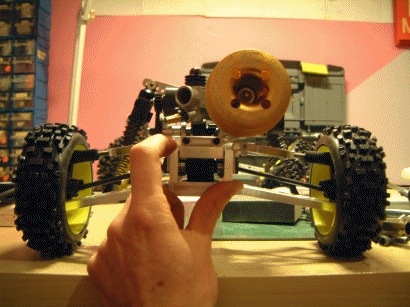Rear
The suspension is definitely my favourite area when building a car. I played around for many hours trying to come up with the best way to arrange the suspension, especially at the rear. Real class-1 buggies almost all run trailing arm rear suspension, which is exceptionally strong. The major problem I kept finding, no matter how I configured a trailing arm design, was the change in length of the driveshafts. I could never get it small enough to be able to use commercial shafts, so I would have had to make my own telescopic shafts and diff outdrives. All possible, but not without a lot of effort on a very vulnerable part. I viewed this as too much of a compromise so decided on double wishbone suspension. The challenge now would be to integrate this while still retaining enough of a scale look as it is a fundamental difference between this car and the real thing.
Designing the wheel tragectories for the rear was not all that difficult, after all these wheels don't have to steer. The problem was placing the mount points with so many other parts getting in the way. Lower wishbones were no problem and I had these made pretty quickly in super tough 8mm 6082. I built 3 degrees of toe-in into them. The top links have to be wrapped around the spur gear on one side and the brake caliper, actuation arm and engine crankcase on the other. This particular part was re-made 3 times until sufficient clearance was achieved at the bottom-out and top-out positions in the suspension travel. I'd like to do the next project vehicle in full 3D CAD with motion simulation which would really help with this kind of problem. In the end I get about 2.5" of wheel travel out of this rear end with many parts having sub-millimetre clearances.
Rear springing is another area where this buggy departs from 4WD machines. Because of the amount of weight placed behind the rear axle, no commercially available RC springs are stiff enough for the rear shocks. To achieve the correct ride height with the stiffest 1/8 scale springs I have requires over 1 inch of preload spacers, and of course the spring rate itself is still far too low. Buying engineering springs of the correct rate is an option, but if multiple rates are required for tuning purposes this can be pretty expensive. I decided to run a separate auxiliary spring in parallel with the standard 1/8 spring on the coilover unit. The aux spring would therefore not need to be very stiff, and changing it's preload would alter the ride height of the rear of the buggy without having to touch the main shock. The whole thing could be wrapped up in a 'piggyback' style unit which would look a lot like the external reservoirs and bypass units the real buggies have.



